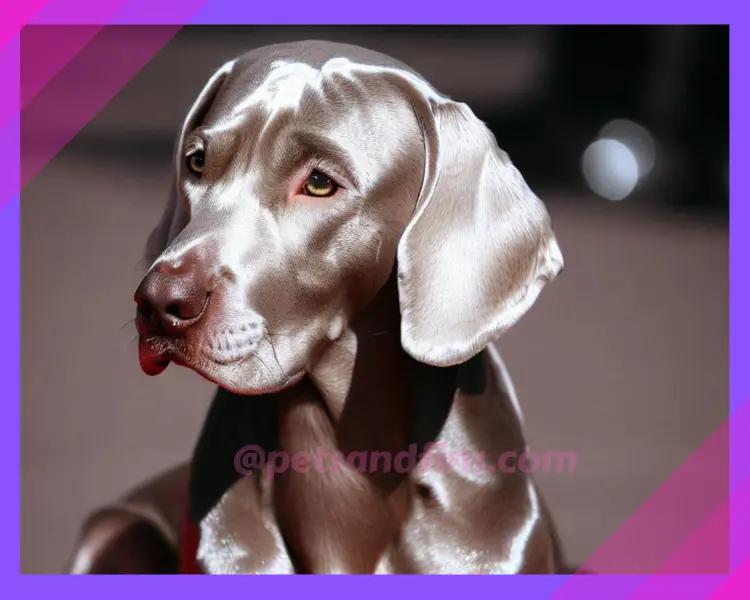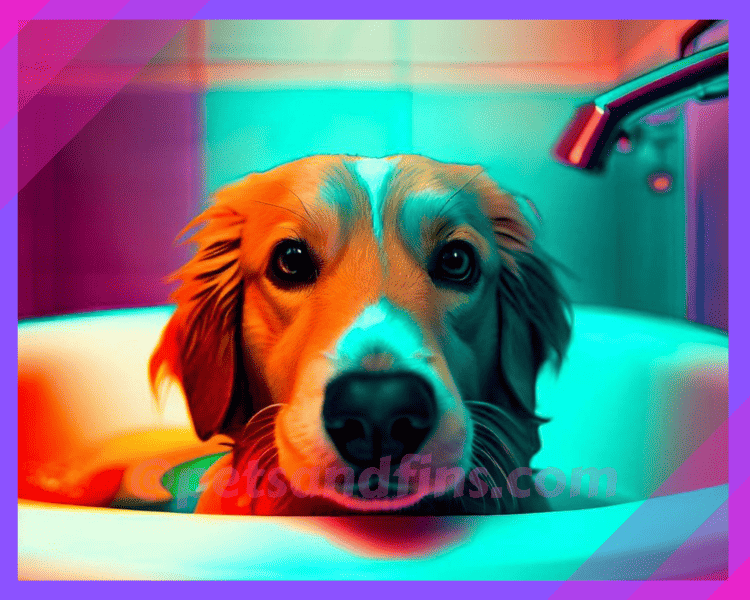This article will deal with 13 Tips To Bathe Senior Dogs. As our beloved furry friends age, their needs change, and it becomes essential to adapt our care routines to ensure their health and well-being. One crucial aspect of senior pet care is maintaining their cleanliness through regular bathing.
Bathing not only helps keep their coats shiny and fresh but also promotes good skin health and helps identify any underlying health issues. However, bathing a senior dog can present unique challenges, such as mobility issues and sensitive skin.
To help you navigate this process with confidence, we have compiled 13 invaluable tips to bathe senior dogs, ensuring a safe, comfortable, and enjoyable experience for both you and your aging companion.
My Experience With My Senior Dog

As a dog lover, I always wanted to give my furry friend Rosy the best care possible. She was a senior dog and had been with me for over 10 years. However, as she grew older, I noticed that she would try to avoid taking a bath. At first, I thought it was just her being stubborn or not liking water. But then I realized that there might be something else going on.
One day, while giving her a bath, I noticed that Rosy seemed to be in pain when moving around. It was then that I realized that she might have joint pain due to old age. As soon as this realization hit me, I felt guilty for not noticing it earlier.
I immediately took her to the vet and got her checked out. The vet confirmed my suspicion and prescribed some medication for her joint pain. After starting the medication, Rosy’s behavior changed drastically – she became more active and playful again.
From then on, whenever it was time for a bath, instead of forcing her into it like before, I would make sure to take extra care of her joints by using warm water and being gentle during the process.
Looking back at those days now brings tears to my eyes because Rosy is no longer with me today. But knowing that I gave her the best care possible during those last few years of her life gives me peace of mind and makes me feel proud of myself as a pet parent.
13 Tips To Bathe Senior Dogs

Senior Dogs Need Extra Grooming Sessions
Senior dogs, just like their human counterparts, require extra care and attention when it comes to grooming. As dogs age, their coat and skin become more delicate and prone to dryness, matting, and irritation.
Therefore, it is crucial to incorporate additional grooming sessions into their routine. Regular brushing helps to remove loose hair, prevent tangles, and distribute natural oils, promoting a healthier and more comfortable coat.
Moreover, senior dogs may develop more sensitive areas, such as arthritis-prone joints or tender skin, so gentle and thorough grooming becomes essential.
These extra grooming sessions not only keep their appearance well-maintained but also serve as a bonding experience between you and your aging companion, providing them with the love and attention they deserve in their golden years.
Know Your Dog
Before you embark on bathing your senior dog, it’s crucial to take the time to know your furry friend inside out. Pay attention to any signs of pain or discomfort they may exhibit, as well as any specific areas of tenderness.
Aging dogs are more prone to joint issues, arthritis, or other ailments that can make certain body parts sensitive or painful. Gently touch and observe your dog’s body, noting any reactions or areas they may flinch or show discomfort.
This knowledge will help you modify your bathing approach to avoid unnecessary stress or pain for your senior companion. Consider adjusting water temperature, supporting tender joints, or using extra caution when handling delicate areas. By understanding your dog’s individual needs and limitations, you can create a bathing experience that is tailored to their comfort and overall well-being.
Use A Mild Shampoo
When it comes to bathing senior dogs with sensitive skin, using a mild shampoo is of utmost importance. Aging dogs are more susceptible to skin irritations, dryness, and allergies, making it crucial to choose a gentle and hypoallergenic shampoo specifically formulated for sensitive skin.
Avoid shampoos that contain harsh chemicals, artificial fragrances, or dyes, as these can further irritate your dog’s delicate skin. Instead, opt for a natural or organic shampoo that is free from potentially irritating ingredients.
These milder shampoos will help maintain the natural oils in your senior dog’s skin, preventing excessive dryness and preserving their skin’s moisture balance. Always read the labels and consult your veterinarian if you’re unsure about the best shampoo option for your senior dog’s specific skin needs.
By using a mild shampoo, you’ll ensure a comfortable and soothing bathing experience that won’t compromise your senior dog’s skin health.
Anti-Skid Mat
When bathing senior dogs, ensuring their safety is paramount, and one crucial tool for maintaining a secure bathing environment is an anti-skid mat. As dogs age, their mobility and balance may decline, making them more prone to slipping and sliding on wet surfaces.
Placing an anti-skid mat in the bathing area provides a stable surface for your senior dog to stand or sit on, reducing the risk of accidents and injuries. These mats are typically made of rubber or other non-slip materials and have suction cups or grip pads on the bottom to firmly adhere to the floor.
The anti-skid mat not only helps your senior dog feel more secure during the bath but also gives you peace of mind, knowing that they won’t lose their footing. Invest in an anti-skid mat to create a safe bathing environment that promotes your senior dog’s comfort and stability throughout the bathing process.
Antibacterial Element
When it comes to bathing senior dogs, choosing a shampoo with an antibacterial element, preferably herbal, can provide added benefits for their aging skin. As dogs get older, their immune systems may weaken, making them more susceptible to infections and skin issues.
Using a shampoo that contains antibacterial properties can help combat bacteria and fungi that may cause skin irritations or infections. Herbal shampoos often utilize natural ingredients like tea tree oil, neem oil, or lavender, known for their antibacterial properties.
These ingredients not only help cleanse the skin but also provide soothing and healing benefits. Additionally, herbal shampoos are typically gentler on the skin and less likely to cause adverse reactions. Before choosing a shampoo, consult your veterinarian to ensure it is suitable for your senior dog’s specific needs.
By opting for a shampoo with antibacterial elements, you can promote healthy skin and prevent potential infections, all while providing a pleasant bathing experience for your senior dog.
Lukewarm Water
When bathing senior dogs, using lukewarm water is essential for their comfort and well-being. As dogs age, they become more sensitive to extreme temperatures, and using water that is too hot or too cold can cause discomfort or even harm.
Lukewarm water is the ideal temperature for bathing senior dogs, as it helps maintain their body temperature while still effectively cleansing their coat and skin. Before starting the bath, test the water temperature with your hand or a thermometer to ensure it’s not too hot.
It’s always better to err on the side of caution and make the water slightly cooler rather than risk scalding your furry friend. By using lukewarm water, you’ll create a pleasant and soothing bathing experience for your senior dog, promoting their relaxation and overall well-being.
Thorough Drying
Thoroughly drying senior dogs after a bath is incredibly important for their health and comfort. Aging dogs may have more difficulty regulating their body temperature and can easily become chilled if left damp.
After bathing, use a soft towel to gently blot and remove excess moisture from your senior dog’s coat. Pay special attention to areas where water may accumulate, such as the ears, armpits, and between the toes.
It’s advisable to use a pet-friendly hairdryer on the lowest heat setting or a warm air setting to further dry their coat, taking care to keep a safe distance to avoid overheating or startling your dog. Additionally, ensure that your senior dog is kept in a warm and draft-free environment until they are fully dry.
By taking the time to thoroughly dry your senior dog, you’ll not only prevent discomfort and potential health issues but also provide them with a cozy and pleasant post-bath experience.
Step Stool
Using a step stool to assist your senior dog in entering the bath tub can make the bathing process much easier and more comfortable for them. As dogs age, they may experience reduced mobility or joint stiffness, making it challenging for them to navigate higher surfaces.
By placing a sturdy and secure step stool near the bath tub, you provide a safe and stable platform for your senior dog to step onto before entering the tub. This helps minimize the risk of slips, falls, or unnecessary strain on their joints.
Choose a step stool that is appropriately sized for your dog’s comfort and ensure it is slip-resistant to provide extra stability. By utilizing a step stool, you make bath time more accessible and less stressful for your senior dog, ensuring a smoother and safer experience for both of you.
Adjust To His Times
When bathing senior dogs, it’s essential to adjust to their individual needs and preferences, including their preferred time for bathing. As dogs age, their routines may change, and they may have specific times of day when they are more alert and comfortable.
Pay attention to your senior dog’s behavior and energy levels throughout the day to determine the best time for their bath. Some senior dogs may be more active and responsive in the morning, while others may prefer a bath in the afternoon or evening.
By accommodating their preferred time, you create a more relaxed and cooperative bathing experience. Additionally, be patient and allow extra time for breaks or rest during the bath if needed. Adapting to your senior dog’s schedule helps minimize stress and ensures a positive and enjoyable bathing session for both of you.
No Surprises
When bathing senior dogs, it’s crucial to avoid surprises or sudden movements that can startle or stress them. As dogs age, they may become more sensitive to changes in their environment or handling.
It’s important to introduce them to the bathing process calmly and gradually. Instead of abruptly placing them into the bathtub, allow them to approach it at their own pace. Use positive reinforcement techniques, such as treats or gentle encouragement, to help them associate the bath with positive experiences.
By providing a predictable and calm environment, you can help alleviate anxiety and create a sense of trust during the bathing process. Avoid sudden movements or loud noises that could startle your senior dog and make the experience more challenging for both of you.
By being patient, understanding, and avoiding surprises, you can make bath time a more comfortable and enjoyable experience for your senior dog.
Reward
Rewarding your senior dog during and after bath time is a powerful way to reinforce positive behavior and create a pleasant association with the bathing experience. As dogs age, they may require more motivation and encouragement to participate in activities, including bathing.
Use treats, praise, and gentle affection to reward your senior dog for their cooperation and calm behavior throughout the bath. This positive reinforcement helps build trust and strengthens the bond between you and your furry companion.
Additionally, rewarding your senior dog after the bath with a special treat or some extra playtime further enhances their positive perception of the bathing process.
By incorporating rewards into the bathing routine, you can turn it into a positive and enjoyable activity for your senior dog, making future bath times easier and more enjoyable for both of you.
Careful With Eyes And Ears
When bathing senior dogs, it’s crucial to be extra careful and gentle when handling their eyes and ears.
As dogs age, their eyes and ears can become more sensitive and prone to irritation. Avoid getting shampoo or water directly into their eyes and ears, as it can cause discomfort and potential infections. Use a damp cloth or a pet-friendly eye and ear cleanser to gently wipe around their eyes and the outer areas of their ears.
Be cautious not to insert anything into the ear canal to prevent injury. If you notice any signs of redness, discharge, or discomfort, consult your veterinarian for proper examination and care.
By being mindful and cautious when caring for your senior dog’s eyes and ears during bath time, you can help maintain their overall health and comfort.
Check For Wounds Before Bathing
Before bathing your senior dog, it is essential to carefully check their body for any wounds or skin abnormalities. Aging dogs may have a higher risk of developing skin issues, such as hot spots, sores, or lumps.
Inspect their skin thoroughly, paying close attention to areas that are prone to friction or pressure, such as under the legs or around joints. If you notice any wounds, redness, swelling, or signs of infection, it is advisable to postpone the bath and seek veterinary attention if necessary.
Bathing a dog with open wounds can potentially worsen the condition or introduce infection. By conducting a thorough pre-bath examination and addressing any wounds or skin concerns, you ensure a safer and more comfortable bathing experience for your senior dog.
Summary
Bathing senior dogs requires a thoughtful and gentle approach that takes into consideration their unique needs and limitations. By following these 13 tips, you can ensure a safe, comfortable, and enjoyable bathing experience for your aging companion.
From assessing their individual needs to using mild shampoos and lukewarm water, each step is designed to promote their well-being. The use of anti-skid mats, step stools, and careful handling of their eyes and ears further enhance their safety and comfort during bath time.
Thorough drying, checking for wounds beforehand, and adjusting to your senior dog’s schedule all contribute to a positive bathing experience. And let’s not forget the importance of rewards and avoiding surprises to make the process more enjoyable for your senior dog.
Remember, as our furry friends age, they require extra care and attention. By implementing these tips, you can ensure that bath time becomes a bonding experience that keeps your senior dog clean, healthy, and happy.
So, embrace the opportunity to care for your senior dog and make their bathing routine a special and cherished moment. They deserve the utmost love and attention in their golden years.
How Do You Give A Senior Dog A Bath?

Giving a senior dog a bath requires a gentle and patient approach to ensure their comfort and safety. Here’s a step-by-step guide on how to give a bath to your aging companion:
Prepare the bathing area: Choose a warm, quiet, and well-ventilated space where you can comfortably bathe your senior dog. Place an anti-skid mat in the tub or on the floor to prevent slips.
Gather necessary supplies: Have everything you need within reach, including a mild and hypoallergenic shampoo suitable for senior dogs, towels, a brush or comb, cotton balls, and pet-friendly eye and ear cleansers.
Brush before bathing: Start by thoroughly brushing your senior dog’s coat to remove any tangles or loose hair. This helps prevent matting and ensures an even distribution of natural oils.
Check for wounds or skin issues: Before wetting your dog, carefully examine their body for any wounds, sores, or skin abnormalities. Postpone the bath and consult your veterinarian if you discover any issues.
Test the water temperature: Fill the tub or basin with lukewarm water. Test the water temperature with your hand or a thermometer to ensure it is comfortable for your senior dog.
Begin bathing: Gently place your senior dog in the tub or use a handheld showerhead to wet their body. Use a mild shampoo specifically formulated for senior dogs and lather it into their coat, taking care to avoid the eyes and ears.
Clean the face: Use a damp cloth or cotton ball to wipe your dog’s face, being cautious around the eyes and mouth. Use a pet-friendly eye cleanser to gently remove any debris from their eyes.
Clean the ears: Moisten a cotton ball with a pet-friendly ear cleanser and gently wipe the outer areas of your dog’s ears. Avoid inserting anything into the ear canal to prevent injury.
Rinse thoroughly: Thoroughly rinse off the shampoo from your senior dog’s coat, ensuring that no residue remains. Use your hand or a jug to pour water over their body gently.
Towel dry: Use a soft towel to carefully blot and remove excess moisture from your dog’s coat. Pay attention to areas where water may accumulate, such as under the belly and between the toes.
Dry the ears: Gently dry the outer areas of your dog’s ears using a clean towel or a soft cloth. Be cautious and avoid rubbing or inserting anything into the ear canal.
Reward and praise: Throughout the bath and drying process, reward your senior dog with treats and praise for their cooperation and good behavior. This positive reinforcement helps create a pleasant association with bathing.
Post-bath care: After your dog is completely dry, brush their coat again to remove any remaining loose hair or tangles. Ensure they are kept in a warm and draft-free environment to prevent them from getting chilled.
Remember, every senior dog is unique, and their bathing routine may require adjustments based on their specific needs and health conditions. Always consult your veterinarian for guidance and follow their recommendations. With patience, love, and proper care, bathing your senior dog can become a nurturing and enjoyable experience for both of you.
How Often Should You Bathe An Elderly Dog?

The frequency of bathing an elderly dog depends on various factors, such as their overall health, activity level, and coat condition. In general, most senior dogs do not require frequent baths unless there is a specific need. Bathing them too often can strip their skin of natural oils, leading to dryness and irritation.
On the other hand, not bathing them regularly enough can result in a dirty and uncomfortable coat. A good rule of thumb is to bathe your elderly dog every 4-6 weeks or as needed. However, it’s important to assess their individual circumstances.
If your senior dog has certain health conditions or skin issues, your veterinarian might recommend a more frequent bathing schedule or specific medicated shampoos.
Regular brushing, spot cleaning, and maintaining good hygiene are also essential for keeping your elderly dog clean and comfortable between baths. Remember, it’s crucial to consider your dog’s unique needs and consult with your veterinarian for personalized advice on how often you should bathe your elderly dog.
How Do You Bathe An Arthritic Dog?

Bathing an arthritic dog requires special attention and care to ensure their comfort and minimize any discomfort or pain. Here are a few key tips to help you bathe an arthritic dog:
Choose a warm and quiet bathing area that provides stability and support.
Use a non-slip mat or provide a sturdy surface for them to stand on.
Use warm water to soothe their joints and muscles.
Consider using a harness or towel sling to assist them in getting into the tub.
Opt for shorter baths, focusing on essential areas.
Use a gentle touch when applying shampoo and avoid putting unnecessary strain on their joints.
Towel-dry them carefully, removing excess moisture without causing discomfort.
Provide a warm and comfortable post-bath environment for their relaxation.
Consult with your veterinarian for specific advice and any additional measures to ensure their comfort and well-being during bath time.
By following these guidelines and being mindful of your arthritic dog’s limitations, you can make bath time a more comfortable and enjoyable experience for them.
How Do You Bathe A Dog With Mobility Issues?

Bathing a dog with mobility issues requires extra care and consideration to ensure their safety and comfort throughout the process. Here are some tips to help you bathe a dog with mobility issues:
Choose a suitable bathing area: Find a warm, quiet, and easily accessible location for bathing your dog. Consider using a raised tub or a non-slip mat on the floor to provide stability and support.
Prepare in advance: Have all the necessary supplies within reach, including a mild shampoo, towels, a brush or comb, and any prescribed medications or supplements.
Provide assistance: If your dog struggles with mobility, use a harness or towel sling to support their weight and help them enter the bathing area. Take your time and be gentle to avoid causing any discomfort or stress.
Minimize stress: Keep the bathing process calm and stress-free. Speak in a soothing voice and offer reassurance to help your dog feel at ease.
Use a handheld showerhead: A handheld showerhead gives you more control over the water flow, allowing you to target specific areas without causing unnecessary discomfort.
Opt for shorter baths: If your dog becomes tired or uncomfortable during bathing, consider dividing the process into shorter sessions to minimize strain on their mobility.
Support their body: Provide extra support for your dog’s body during the bathing process. Be mindful of their joints and use a gentle touch when handling or moving their limbs.
Take breaks if needed: If your dog shows signs of fatigue or becomes overwhelmed, take breaks during the bath. Allow them time to rest and regather their strength before continuing.
Remember, the key to bathing a dog with mobility issues is to prioritize their comfort and safety. Adapt the bathing routine to suit their individual needs, and consult with your veterinarian for any specific recommendations or accommodations to ensure a positive bathing experience for your furry friend.
References
1. American Kennel Club (AKC). (2021). Bathing Your Senior Dog: Tips for Keeping Them Clean & Comfortable. 7 Easy Ways to Keep Your Senior Dog Happy – American Kennel Club (akc.org)
2. PetMD. (2021). How Often Should You Bathe Your Senior Dog?
3. The Spruce Pets. (2021). How to Bathe a Senior Dog.
4. VCA Hospitals. (2021). Bathing Your Older Dog. 5. WebMD Pets Health Center. (2021).

